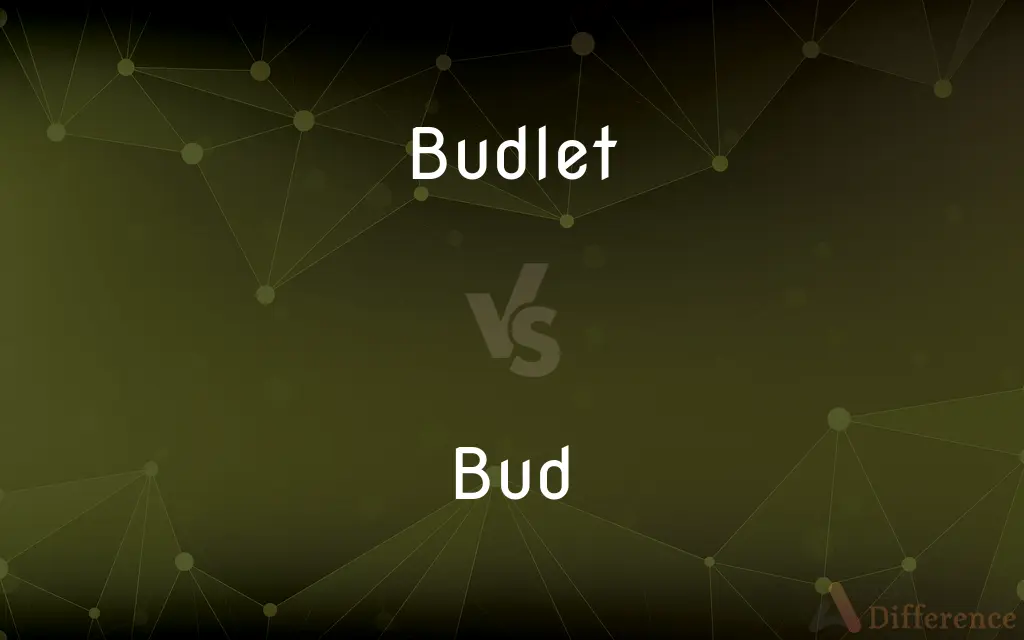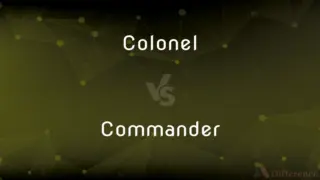Budlet vs. Bud — What's the Difference?
By Tayyaba Rehman & Urooj Arif — Updated on April 16, 2024
A budlet is a small, immature bud, often a precursor to full development, whereas a bud is a more developed structure from which flowers or leaves emerge.

Difference Between Budlet and Bud
Table of Contents
ADVERTISEMENT
Key Differences
A budlet refers to the initial stages of a bud's development, typically very small and just beginning to form. Buds, on the other hand, are more mature developmental stages of a plant that are ready to produce new leaves, flowers, or shoots.
Budlets are often observed as tiny protrusions on plants, signaling the beginning of new growth. While buds are clearly visible and indicate where new plant elements will soon emerge.
In terms of development, budlets represent the potential for new growth and are critical in the early stages of a plant's life cycle. Whereas buds are closer to actualizing that potential, often transitioning into blooming flowers or expanding leaves.
Budlets may not be immediately noticeable unless closely inspected due to their size. Buds, however, are generally easier to spot and can be indicative of the plant's current health and growth stage.
The presence of budlets can be a sign of a healthy, actively growing plant, as they are indicators of future development. Buds demonstrate ongoing growth and may also reflect the plant's reproductive phase, especially when they begin to flower.
ADVERTISEMENT
Comparison Chart
Definition
An immature, small precursor to a full bud.
A mature, developmental stage of a plant.
Visibility
Less noticeable, very small.
Clearly visible, larger in size.
Stage of Growth
Initial stages of development.
Nearer to fruition, ready to produce leaves or flowers.
Indicator of
Potential and beginning of new growth.
Health and ongoing growth, possibly reproductive phase.
Typical Observation
Requires close inspection to be seen.
Easily identifiable on the plant.
Compare with Definitions
Budlet
A very young, undeveloped bud beginning to form on a plant.
The gardener pointed out the budlets forming along the stem of the rose.
Bud
An identifiable point on a plant where new life begins.
Each spring, the buds on the bushes swell just before they bloom.
Budlet
An immature plant structure with potential for growth.
Each budlet has the potential to turn into a flowering branch.
Bud
A plant structure signaling near-term growth of leaves or flowers.
He pruned the tree carefully, mindful not to cut off any healthy buds.
Budlet
The earliest stage of a bud visible on a plant.
Tiny budlets are the first signs of new life in early spring.
Bud
The part of the plant that indicates health and vitality.
Healthy buds are a good sign of a plant’s overall well-being.
Budlet
A small indication of future plant development.
Observing budlets can help gardeners predict the flowering patterns of plants.
Bud
An indicator of seasonal change in many plants.
The emergence of buds is one of the first signs of spring.
Budlet
A precursor to a fully developed plant bud.
The horticulturist explained how each budlet could develop under the right conditions.
Bud
A mature formative part of a plant from which leaves or flowers develop.
The buds on the apple tree were ready to burst open.
Budlet
A little bud springing from a parent bud.
Bud
In botany, a bud is an undeveloped or embryonic shoot and normally occurs in the axil of a leaf or at the tip of a stem. Once formed, a bud may remain for some time in a dormant condition, or it may form a shoot immediately.
Budlet
A little bud springing from a parent bud.
We have a criterion to distinguish one bud from another, or the parent bud from the numerous budlets which are its offspring.
Bud
A small protuberance on a stem or branch, sometimes enclosed in protective scales and containing an undeveloped leaf, flower, or leafy shoot.
Bud
The stage or condition of having buds
Branches in full bud.
Bud
Flowers from a female cannabis plant, especially after being harvested and prepared for smoking or other use
Bought some bud.
Bud
A single flower of a cannabis plant, especially a female flower
When to harvest buds.
Bud
A small, rounded organic part, such as a taste bud, that resembles a plant bud.
Bud
One that is not yet fully developed
The bud of a new idea.
Bud
An earbud.
Bud
Friend; chum. Used as a form of familiar address, especially for a man or boy
Move along, bud.
Bud
To put forth or produce buds
A plant that buds in early spring.
Bud
To develop or grow from or as if from a bud
"listened sympathetically for a moment, a bemused smile budding forth" (Washington Post).
Bud
To be in an undeveloped stage or condition.
Bud
To cause to put forth buds.
Bud
To graft a bud onto (a plant).
Bud
A newly sprouted leaf or blossom that has not yet unfolded.
After a long, cold winter, the trees finally began to produce buds.
Bud
A small rounded body in the process of splitting from an organism, which may grow into a genetically identical new organism.
In this slide, you can see a yeast cell forming buds.
Bud
Potent cannabis taken from the flowering part of the plant (the "bud"), or marijuana generally.
Hey bro, want to smoke some bud?
Bud
A weaned calf in its first year, so called because the horns are then beginning to bud.
Bud
A pretty young girl.
Bud
Buddy, friend.
I like to hang out with my buds on Saturday night.
Bud
Used to address a male
Bud
(intransitive) To form buds.
The trees are finally starting to bud.
Bud
(intransitive) To reproduce by splitting off buds.
Yeast reproduces by budding.
Bud
(intransitive) To begin to grow, or to issue from a stock in the manner of a bud, as a horn.
Bud
(intransitive) To be like a bud in respect to youth and freshness, or growth and promise.
Bud
(transitive) To put forth as a bud.
Bud
(transitive) To graft by inserting a bud under the bark of another tree.
Bud
A small protuberance on the stem or branches of a plant, containing the rudiments of future leaves, flowers, or stems; an undeveloped branch or flower.
Bud
A small protuberance on certain low forms of animals and vegetables which develops into a new organism, either free or attached. See Hydra.
Bud
To put forth or produce buds, as a plant; to grow, as a bud does, into a flower or shoot.
Bud
To begin to grow, or to issue from a stock in the manner of a bud, as a horn.
Bud
To be like a bud in respect to youth and freshness, or growth and promise; as, a budding virgin.
Bud
To graft, as a plant with another or into another, by inserting a bud from the one into an opening in the bark of the other, in order to raise, upon the budded stock, fruit different from that which it would naturally bear.
The apricot and the nectarine may be, and usually are, budded upon the peach; the plum and the peach are budded on each other.
Bud
A partially opened flower
Bud
A swelling on a plant stem consisting of overlapping immature leaves or petals
Bud
Develop buds;
The hibiscus is budding!
Bud
Start to grow or develop;
A budding friendship
Common Curiosities
How do you identify a bud versus a budlet?
Buds are larger, more visible, and closer to producing leaves or flowers, while budlets are smaller and less developed.
What does the presence of budlets on a plant indicate?
The presence of budlets indicates that the plant is healthy and in the early stages of new growth.
Are budlets always visible to the naked eye?
Not always; budlets can be quite small and may require close inspection to be seen clearly.
Is it possible for a plant to have both buds and budlets?
Yes, it's common for plants to have both, especially during their growing season.
How do gardeners care for budlets?
Gardeners should ensure optimal conditions by regulating water, light, and nutrients, much like caring for mature buds.
Can a budlet develop into a flower?
Yes, a budlet can develop into a bud and then potentially a flower, depending on the plant type.
What role do budlets play in plant reproduction?
Budlets are initial stages of growth that can lead to the development of reproductive structures like flowers.
Can budlets be damaged easily?
Yes, due to their immature state and small size, budlets are more susceptible to damage from pests, diseases, or environmental stresses.
How can the health of a budlet affect the future growth of the plant?
Healthy budlets are crucial for the proper development of buds and the subsequent growth of the plant, affecting overall vitality and productivity.
What is a budlet?
A budlet is an early, undeveloped stage of a bud on a plant, indicating initial growth.
What factors influence the development of budlets into buds?
Factors include environmental conditions, water availability, nutrient supply, and the overall health of the plant.
How long does it take for a budlet to develop into a bud?
This depends on the plant species and environmental conditions but typically spans several weeks.
Do all plants produce budlets?
Most plants that grow from buds will pass through a budlet stage as part of their development cycle.
Are there any specific signs that a budlet is not developing properly?
Signs include discoloration, stunted growth, or wilting, which may indicate poor health or adverse environmental conditions.
What is the difference in care between a budlet and a bud?
Care routines are similar, focusing on providing sufficient nutrients and protecting from adverse conditions; however, budlets may require more delicate handling due to their immature state.
Share Your Discovery

Previous Comparison
Transom vs. Clerestory
Next Comparison
Colonel vs. CommanderAuthor Spotlight
Written by
Tayyaba RehmanTayyaba Rehman is a distinguished writer, currently serving as a primary contributor to askdifference.com. As a researcher in semantics and etymology, Tayyaba's passion for the complexity of languages and their distinctions has found a perfect home on the platform. Tayyaba delves into the intricacies of language, distinguishing between commonly confused words and phrases, thereby providing clarity for readers worldwide.
Co-written by
Urooj ArifUrooj is a skilled content writer at Ask Difference, known for her exceptional ability to simplify complex topics into engaging and informative content. With a passion for research and a flair for clear, concise writing, she consistently delivers articles that resonate with our diverse audience.
















































